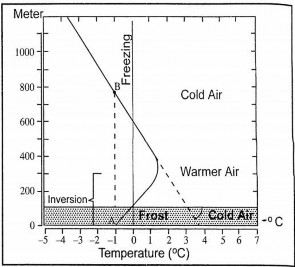3.3. Temperature Inversion
As already discussed, temperature decreases with increase in altitude. In normal conditions, as we go up, temperature decreases with normal lapse rate. It is 6.5°C per 1,000 m. Against this normal rule sometimes, instead of decreasing, temperature may rise with the height gained. The cooler air is nearer the earth and the warmer air is aloft. This rise of temperature with height is known as Temperature inversion. Temperature inversion takes place under certain specific conditions. These are discussed below:
♤ Long winter nights: if in winters the sky is clear during long nights, the terrestrial radiation is accelerated. The reason is that the land surface gets cooled fairly quickly. The bottom layer of atmosphere in contact with the ground is also cooled and the upper layer remains relatively warm.
♤ Cloudless clear sky: The clouds obstruct the terrestrial radiation. But this radiation does not face any obstacles for being reflected into space when the sky is clear. Therefore the ground is cooled quickly and so is the air in contact with it cooled.

